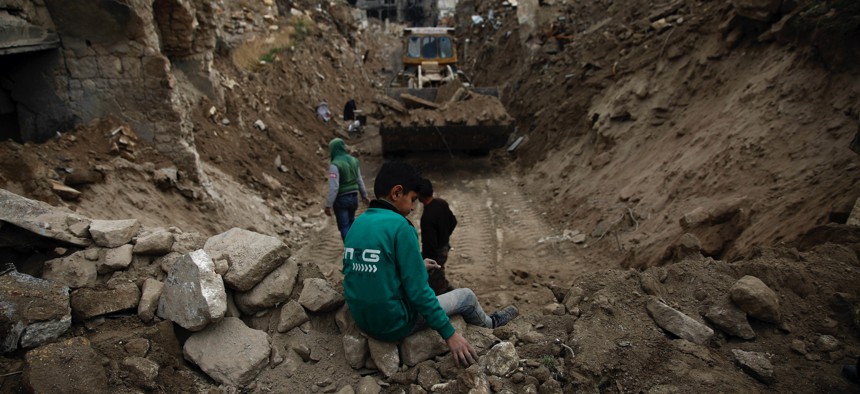
In this Jan. 18, 2018 photo, a bulldozer removes rubble next to the heavily damaged Grand Umayyad Mosque in the Old City of Aleppo, Syria. AP / Hassan Ammar
Trump’s Threat to Bomb Iran's Cultural Sites Isn’t Just About Art
Throughout history, the destruction of culturally important sites has gone hand-in-hand with violence against civilians.
On Sunday, President Trump doubled down on his threat to target Iranian cultural sites, an act strictly outlawed under international law. “They’re allowed to use roadside bombs and blow up our people. And we’re not allowed to touch their cultural sites? It doesn’t work that way,” the president told reporters aboard Air Force One. It’s hardly the first example of Trump’s disregard for international norms and America’s treaty promises, but something stands out: a thinly veiled threat to attack innocent Iranians.
The main objective of targeting cultural sites is to attack and eradicate groups of people with shared cultural, national, religious, or ethnic identities. History shows that the destruction of cultural sites is often tied to the abuse of civilian populations. Most recently, we have seen ISIS desecrate cultural sites while committing other atrocities in Syria and Iraq, but this violent phenomenon is not new. In the 1998–1999 Kosovo War, Serb nationalist forces systematically destroyed mosques and other Islamic sites as part of a genocidal ethnic cleansing campaign against Muslim Kosovar Albanians. The Kristallnacht attack on synagogues foreshadowed the Nazi genocide. The list goes on.
The U.S. is no stranger to destroying cultural sites. During the 2003 invasion of Iraq, U.S. forces built a military base on top of Babylon, damaging the renowned archaeological site. While the U.S. military was clearly negligent in this case, there is little evidence to suggest that the base’s location was picked with destruction in mind. A Trump-directed attack on Iranian cultural sites would be a different story.
Targeting cultural sites is about targeting people. Attacks on physical representations of a group’s identity are attacks on that identity. But even more concretely, they open the door to wider violence against civilians. Once cultural sites are on the table as potential targets, it is easier to include other non-military targets as well.
Related: Don't Trust the Taliban With Afghanistan’s Cultural Preservation
By threatening to target Iranian cultural sites, Trump revealed that he wants to inflict harm not simply on the Iranian government but on the Iranian people. While human suffering is an inherent part of war, not all parts of war need be designed to make humans suffer. Americans who see compelling strategic reasons for a more hawkish stance towards Iran would do well to question why the president is starting to grab certain tools in the U.S. military toolbox, ones that make ordinary people suffer.
U.S. policy towards Iran already brings considerable suffering to the Iranian people in the form of sanctions, but there is at least a policy rationale for sanctions. Those who advocate for sanctions will say that normal Iranian citizens must, unfortunately, suffer if their government is to effectively feel a campaign of maximum pressure. Targeting cultural sites, on the other hand, offers no strategic benefit; there is only suffering.
There is, of course, the question of deterrence. Is it possible that the U.S. president is just signaling his resolve? After all, the idea of taking Trump seriously but not literally is by now an old idea. And on Tuesday, he walked back his earlier statements. But in a situation in which information asymmetries can quickly lead to escalation, such rhetoric is dangerous.
If Trump is indeed mulling the targeting of cultural sites, every American should take a moment to reflect on the president’s motivations for edging towards war with Iran. Would an American attack on Iran create a safer world, or would it just serve to make Iranian citizens—normal people just trying to live their lives—suffer?